FY2018 Annual Report
Developmental Neurobiology Unit
Associate Professor Ichiro Masai
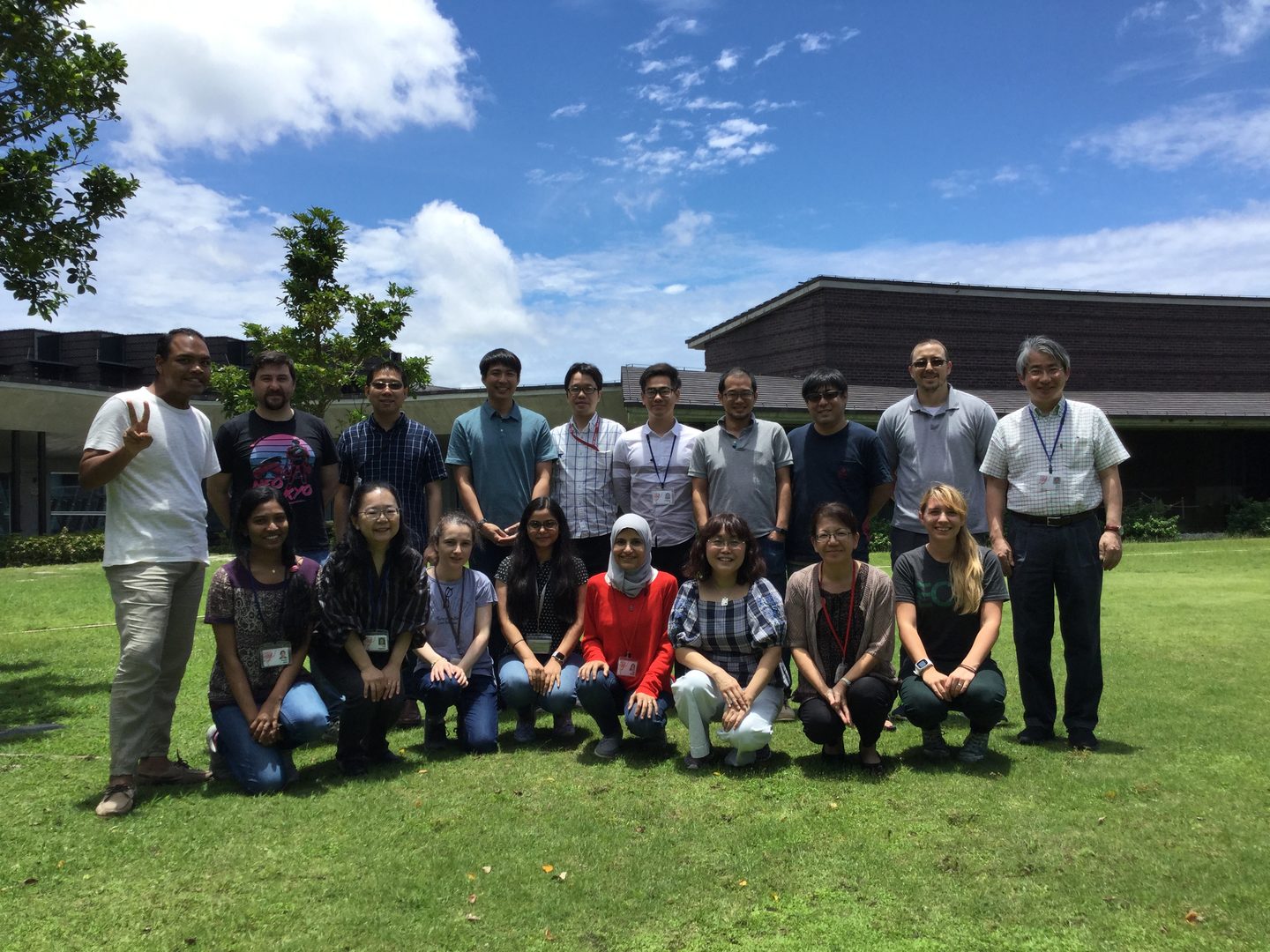
Abstract
Developmental neurobiology unit uses zebrafish as an animal model and will elucidate genetic program that regulate eye development. Specific research projects are to elucidate:
- Mechanisms that regulate retinal cell differentiation and neural circuit formation
- Mechanisms that regulate photoreceptor degeneration
- Mechanisms that regulate lens fiber differentiation
During vertebrate development, the retina is originally derived from anterior neural plate. In this region, six major classes of retinal neurons differentiate and form neural circuits responsible for vision. Thus, the retina provides a good model for studying cell differentiation and neural circuit formationin the developing brain.First, we will investigate mechanisms that regulate cell differentiation and neural circuit formation. Second, we will investigate mechanisms that regulate photoreceptor degeneration. Photoreceptor degeneration is an important topic for medical research, because more than 300 genetic mutations are associated with photoreceptor degeneration in humans. We focus on zebrafish mutants, in which photoreceptor degeneration is caused by defects in protein synthesis in ER, protein transport from ER to the apical photoreceptive membrane region, and phototransduction. Through these mutant analyses, we will determine how photoreceptors monitor abnormalities in cellular functions and trigger apoptosis. We will also investigate the role of microglia in photoreceptor degeneration. Third, we will investigate lens development.The lens is an intraocular organ that focuses visual image on retinal photoreceptors. Lenses consist of two cell-types: lens epithelial cells and lens fiber cells. Lens epithelial cells differentiate into lens fiber cells, each of which are integrated in a stereotyped geometric pattern to form spherical lens fiber core. We will investigate mechanisms that regulate lens fiber differentiation. Through these projects, we will establish key concepts that govern development of multicellular organisms and also contribute to our understanding of pathological processes of human retinal diseases.
1. Staff
- Dr. Yuko Nishiwaki, Group leader
- Dr. Yuki Sugiyama, Staff scientist
- Dr. Yuki Takeuchi, Staff scientist
- Dr. Chong Yee Hang, Postdoctral scholar (HFSP)
- Ms. Nishtha Ranawat, phD student
- Ms. Manana Kutsia, phD student
- Ms. Mai Omar Abdulrahman Ahmad, phD student
- Ms. Swathy Babu, phD student
- Mr. Bedish Chatterjee, phD student
- Mr. Hung-Ju Chiang, phD student
- Mr. Yutaka Kojima, Technician
- Mr. Kevin Jeff Liner, Technician
- Ms. Kimberlie Ward, Technician
- Dr. Tetsuya Harakuni, Technician
- Dr. Mamoru Fujiwara, Technician (Tempo staff)
- Ms. Moe Inafuku, Laboratory Assistant
- Ms. Chitose Mizuta, Laboratory Assistant
- Ms. Rui Inoue, Laboratory Assistant
- Ms. Satsuki Asato, Laboratory Assistant
- Ms. Madoka Makiya, Research Assistant (Tempo staff)
- Ms. Maki Ishikawa, Research Assistant (Tempo staff)
- Ms Ayako Gima, Research Administrator/Secretary
- Ms. Rebecca Arnold, Intern
- Ms. Mariia Pavelchenko, Intern
- Ms. Sushmita Senapati, Intern
2. Collaborations
2.1 The Title or Name or Topic of the Collaboration
- Theme: In vivo functional analysis of hypoxia response genes using the zebrafish retina
- Type of collaboration: Joint research agreement
- Researchers:
- Dr. Ichiro Masai (Developmental neurobiology unit, OIST)
- Dr. Masayuki Matsushita (Department of Medicine, Ryukyu University)
2.2 The Title or Name or Topic of the Collaboration
- Theme: Role of zebrafish nuclear protein in tumor suppression of melanoma
- Type of collaboration: Joint research agreement
- Researchers:
- Dr. Ichiro Masai (Developmental neurobiology unit, OIST)
- Dr. Yutaka Kikuchi (Department of Biological Science, Hiroshima University)
3. Activities and Findings
3.1 Mechanism underlying photoreceptor degeneration
Apoptosis is observed in developing tissues and is believed to remove abnormal cells. Although apoptosis is important for establishment of proper neural circuits by eliminating abnormally differentiated neurons, it is unclear how differentiating cells monitor their own abnormality, and how the threshold at which apoptosis is induced is determined. Photoreceptors provide a useful model for studying such a surveillance mechanism of neuronal development and homeostasis, because there are many hereditary retinal diseases in humans associated with photoreceptor degeneration. Although 271 genes linked to hereditary retinal diseases have already been identified, these genes encode diverse functions, including phototransduction, retinol metabolism, and intracellular protein transport. To answer how photoreceptors monitor their differentiation status and homeostasis, and what kinds of molecular network determine the choice between cell survival and cell death in photoreceptors, we have investigated zebrafish mutants in which photoreceptor degeneration is triggered by defects in phototransduction, intracellular vesicular transport, and intraflagellar transport via the primary cilium. We also investigated the role of brain-resident immune cells, microglia, in photoreceptor degeneration.
3.1.1 Mechanism of photoreceptor degeneration in response to vesicular fusion defects
Intracellular protein transport is mediated by transport vesicles and its defects are often linked to photoreceptor degeneration in humans. However, it is uncertain how vesicular transport defects cause photoreceptor degeneration. We isolated zebrafish β-soluble N-ethylmaleimide-sensitive factor attachment protein (β-SNAP) mutants, in which photoreceptors differentiate, but undergo apoptosis prior to maturation (Nishiwaki et al., 2013) (Fig. 1A). β-SNAP cooperates with N-ethylmaleimide-sensitive factor (NSF) to promote recycling of SNAP receptors (SNARE), a key component of vesicular fusion machinery, by disassembling the cis-SNARE complex generated in the vesicular fusion process (Jahn and Scheller, 2006). Because it is likely that all combinations of cis-SNARE complexes fail to be disassembled in β-SNAP mutants, the mutant provides a good model for studying how vesicular transport defects cause apoptosis in photoreceptors. We found that photoreceptor apoptosis in β-SNAP mutants depends on one of t-SNARE proteins, BNip1. BNip1 normally regulates retrograde transport from Golgi to ER as a t-SNARE component of the syntaxin-18 complex. Interestingly, BNip1 has the BH3 domain, which activates apoptosis via modulation of apoptotic regulators Bax and Bcl2. We found that loss of β-SNAP induces accumulation of syntaxin-18 cis-SNARE complex, in which the BNip1 BH3 domain is activated to induce apoptosis. Thus, the syntaxin-18 cis-SNARE complex functions as an alarm factor that monitors vesicular fusion competence, and BNip1 transforms vesicular fusion defects into photoreceptor apoptosis (Fig. 1B) (Nishiwaki et al., 2013). To our knowledge, BNip1 is the first molecule that directly links vesicular fusion defects and apoptosis.

Fig. 1: Surveillance machanism that monitors vesicular fusion defects in photoreceptor
(A) Wild-type and β-SNAP mutant retina. Photoreceptors are labeled in magenta. In β-SNAP mutants, photoreceptors once differentiate (arrowheads) quickly undergo degeneration. (B) Syntaxin-18 cis-SNARE complex functions as an alarm of vesicular fusion defects. β-SNAP normally disassemble the cis-SNARE complex for SNARE recycle. In β-SNAP mutants, syntaxin-18 cis-SNARE complex is accumulated, and then the BNip1 BH3 domain is activated to induce Bax-dependent apoptosis. This system converts vesicular fusion defects into apoptotic program.
Next, we investigated a physiological role of BNip1-dependent apoptosis. In zebrafish β-SNAP mutants, photoreceptors undergo apoptosis mainly in a small time window of developmental stages, 2 - 4 dpf in which apical photoreceptive membrane structure, called the outer segment (OS) rapidly grows. Since protein synthesis and transport to the OS are highly active in this period, photoreceptor apoptosis in β-SNAP mutants correlates with high levels of protein transport. We examined a critical period of β-SNAP for photoreceptor maintenance by overexpressing β-SNAP under the control of heat shock promoter in β-SNAP mutants (Fig. 2A). We found that overexpression of b-SNAP in 2-5 dpf is enough to prevent photoreceptor apoptosis in zebrafish β-SNAP mutants at least until 21 dpf (Fig. 2B, C). These data raise the possibility that BNip1-mediated apoptosis links to excessive activation of vesicular transport associated with rapid growth of the OS. Consistently, knockdown of IFT88 and Kif3b, which inhibits transport to the OS, rescued photoreceptor apoptosis in β-SNAP mutants. The treatment of rapamycin, which inhibits protein synthesis through mTOR pathway, also rescued photoreceptor apoptosis in b-SNAPmutants. Importantly, the ER stress response is not activated 2-3 dpf in β-SNAP mutants. Taken together, these data support our model in which BNip1 performsrisk assessment that detects excessive vesicular transport in photoreceptors (Fig. 3). In general, deletion of b-SNAP activity compromises recycling of SNARE proteins, which eventually arrests all intracellular protein transport from ER to plasma membrane. In this case, it is likely that the ER stress response is activated to induce apoptosis. However, our study of zebrafish β-SNAP mutants indicates that prior to activation of the ER stress response, BNip1 detects vesicular fusion defects during a rapid OS growth period. Thus, photoreceptors use two different surveillance mechanisms, BNip1 and ER stress response, to monitor the upper and lower ranges of vesicular transport during development.
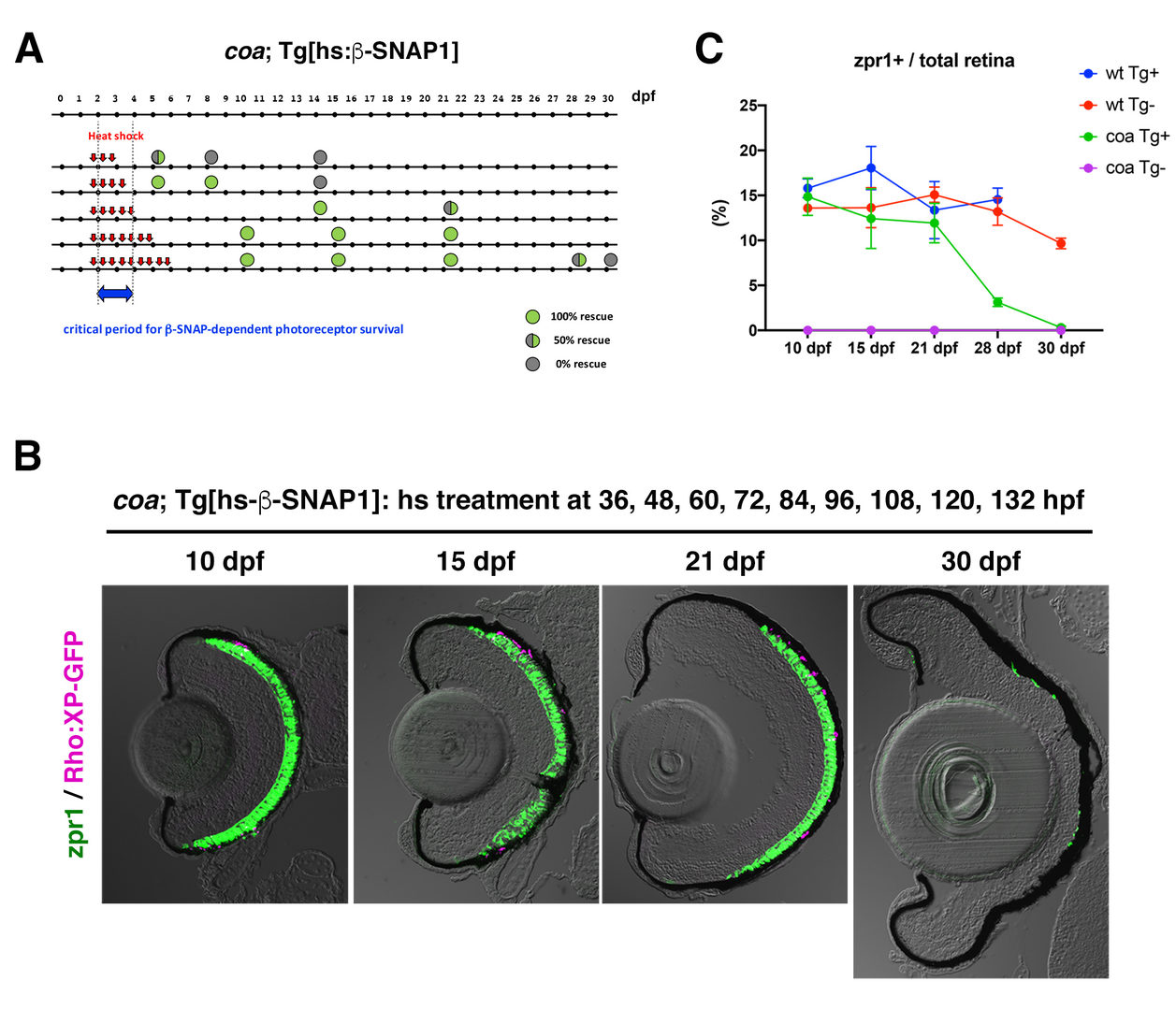
Experimental design and results of heat shock promoter-driven β-SNAP1 overexpression in b-SNAP1 mutants, coa. Zebrafish transgenic line, Tg[hs:β-SNAP1], were treated with heat treatment at different time points with a 12 hours interval in the period from 36 to 132 hpf. Red arrows indicate one hour-pulsed heat shock treatment at 37oC. Green or grey colored circle indicate the rescue results and its position indicates stage when embryos or larvae were fixed with PFA for analysis. Blue arrow indicates the critical period for β-SNAP1-dependent photoreceptor survival.
Retinas of coa; Tg[rho:XP:GFP]; Tg[hs:β-SNAP1] embryos or larvae, which were treated with heat shock nine times at 36, 48, 60, 72, 84, 96, 108, 120, and 132 hpf. Photoreceptors and their OS were visualized by labeling with zpr1 antibody (green) and GFP signals from Tg[rho:XP:GFP] (magenta), respectively. Photoreceptors were maintained at 10, 14, 21 dpf, but degenerated at 30 dpf.
Time line of percentage of zpr1-positive area relative to total retinal area at 10, 15, 21, 28 and 30 dpf. Average percentage of wild-type and coamutant embryos with and without Tg[hs:β-SNAP1]. Photoreceptors survived in coamutant embryos with Tg[hs:β-SNAP1] by 21 dpf, degenerated at 28 dpf and completely eliminated at 30 dpf (green line).
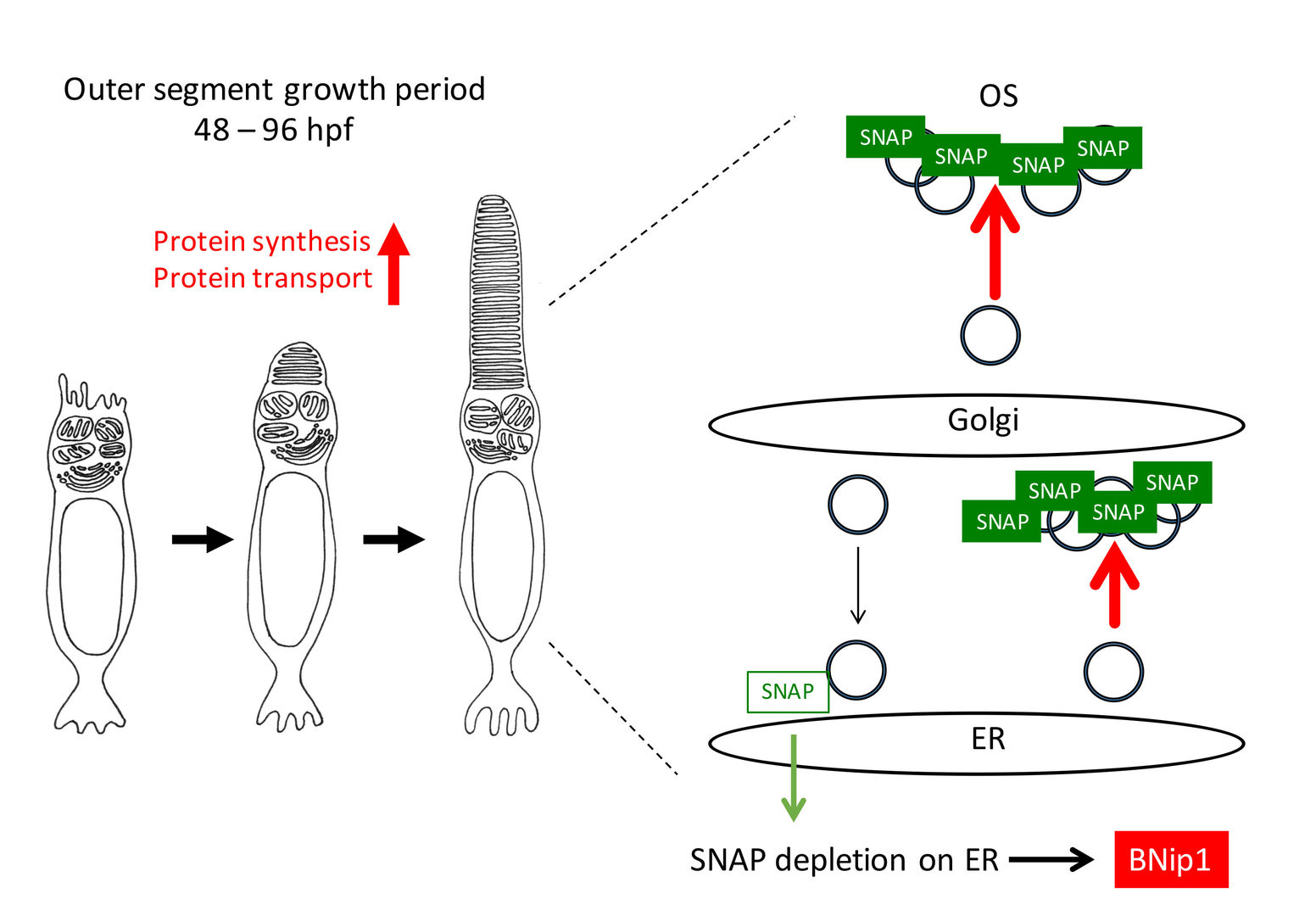
In zebrafish photoreceptors, the OS rapidly grows in 2-4 dpf, suggesting that protein synthesis and transport to the OS are highly activated in this period. Highly activation of vesicular transports may require β-SNAP molecules in vesicular fusion sites, which subsequently decreases a relative contribution of β-SNAP on vesicular fusion sites on ER membrane. In this case, it is likely that cis-SNARE complex of syntaxin-18 is accumulated, leading to the activation of BNip1 BH3 domain and Bax activation in mitochondria. In this model, BNip1 monitors excessive activation of vesicular transport during the OS growth period.
3.1.2 Mechanism of photoreceptor degeneration in response to defects in phototransduction
In vertebrate phototransduction (Fig. 4A), photon absorption by rhodopsin or opsins activates a G-protein, Transducin, followed by activation of cGMP phosphodiesterase 6(PDE6). PDE6 catalyzes cGMP hydrolysis, and then reduction of cGMP closes cyclic-nucleotide gated (CNG) channels on the plasma membrane. Closure of CNG channels reduces intracellular Ca2+levels, which halts neurotransmitter release from photoreceptors. In a recovery phase, reduced [Ca2+] in turn activates guanylate cyclases (GC) to synthesize cGMP, which reopens CNG channels. Thus, coupling of PDE6 and GC via [Ca2+] is important for cGMP homeostasis during phototransduction. Proper regulation of the intracellular concentration of cGMP is important for photoreceptor maintenance, because a high level of cGMP is toxic to rod photoreceptors in humans and mice (Iribarne and Masai, 2017). Indeed, genetic mutations in the rod-specific subunits of PDE6, PDE6α and PDE6β, cause rod degeneration known as retinitis pigmentosa in humans (Gal et al., 1994; Huang et al., 1995; McLaughlin et al., 1995; McLaughlin et al., 1993). However, it is unknown how high levels of cGMP cause photoreceptor cell death. Furthermore, no mutations in the cone-specific α' subunit of PDE6, PDE6α' have been found in humans (Gao et al., 1999). Thus, it is unknown whether a high level of cGMP is toxic to cone photoreceptors. Previously, we reported that cone photoreceptors are specifically eliminated in zebrafish pde6α' mutants (Fig. 4B) (Nishiwaki et al., 2008). Thus, PDE6 activity is important for cone photoreceptor survival. In humans, loss of rod PDE6 mutations cause rod degeneration followed by cone degeneration. In contrast, rods are maintained at adult stages in zebrafish pde6α' mutants, suggesting that interdependence between rods and cones for survival is not mutual (Fig. 4C). Indeed, human pde6α' patients show a similar progressive cone dystrophy and achromatopsia, suggesting that zebrafish pde6α' mutants provide a good model for understanding pathological processes of cone degeneration diseases such as achromatopsia.

(A) Vertebrate phototranduction. cGMP is a key second messenger, which is regulated by PDE6 and GC. (B) Adult retinas of wild-type and cone PDE6 mutant in zebrafish. (C) Interdependence of rod and cone photoreceptor survival. Rod degeneration induces cone degeneration through an unknown bystander effect, but cone degeneration does not cause rod degeneration in zerafish and humans, leading to Achoromatopsia.
gold rush (gosh) was originally isolated by the Dr. Herwig Baier group as a zebrafish mutant that showed no optomotor behavior (Muto et al., 2005). We found that gosh mutants show a very similar cone-specific degeneration to zebrafish pde6α' mutants (Fig. 5A). However, complementation tests between zebrafish pde6α' mutants and gosh mutants indicated that goshmutational loci are different from pde6α'. Our cloning of the goshmutant gene revealed that the goshmutant gene encodes aryl hydrocarbon receptor interacting protein-like 1b (AIPL1b) (Iribarne et al., 2017). In humans, genetic mutations in AIPL1 cause photoreceptor degeneration associated with Leber congenital amaurosis 4 (LCA4), which causes rod and cone dystrophy. In zebrafish, there are two AIPL1 genes, AIPL1a and AIPL1b, which are expressed in rods and cones, respectively. Thus, gosh mutants lack only cone-specific AIPL1 activity. In contrast, humans and mice have only one AIPL1 gene, which is expressed in both rods and cones. It was reported that rod PDE6 activity is drastically reduced in mouse AIPL1 mutants, suggesting that AIPL1 functions as a chaperone for rod-specific subunits of PDE6. However, it is unknown whether AIPL1 regulates the cone-specific subunit of PDE6, PDE6α'. We found that cone-specific PDE6 is markedly reduced in goshmutants, suggesting that APIL1 is essential for the maintenance of cone PDE6 activity. Unexpectedly, we found that cone-specific GC, namely GC3, is markedly reduced in zebrafish pde6α'and goshmutants. Furthermore, PDE6α' and AIPL1 are also reduced in GC3 morphants, suggesting functional coupling between PDE6, GC, and AIPL1 activity (Fig. 5B). These studies indicate that cGMP metabolism is important for cone photoreceptor survival and provides an insight into the pathological process of human Achromatopsia.

(A) Cone-specific AIPL1 mutant zebrafish show cone-specific degeneration but maintain rod photoreceptors, which is very similar to retinal phenotypes of zebrafishpde6a′mutants. (B) Functional coupling of PDE6α′, GC3, and AIPL1. PDE6α′ and GC3 regulate the level of cGMP, which open plasma membrane-associated Ca2+channel CNGA3/CNGB3, leading to the maintenance of cytoplasmic Ca2+level. Cytoplasmic Ca2+inhibits GC3 activity. APIL1 stabilizes PDE6α′activity as a chaperon. PDE6α′ and GC3 mutually maintain their protein expression probably through co-transport system to the OS.
3.2 The role of microglia in retinal development and degeneration
Microglia are brain-resident immune cells, originally derived from mesoderm-derivative tissue or the hematopoietic stem cell-lineage, that migrate into brain, and patrol within the brain throughout life. Microglia are thought to eliminate dead or dying neurons to prevent inflammation. Interestingly, microglia-mediated inflammation is required for neuronal regeneration in response to traumatic brain injury in zebrafish (Kyritsis et al., 2012), suggesting more dynamic roles of microglia in neuronal damage. Furthermore, surprisingly, it was reported that microglia facilitate rod cell death in rod-PDE6 mutant mice, which contrasts with our previous view that microglia promote neuronal protection (Zhao et al., 2015). Thus, it is important to understand the role of microglia in photoreceptor degeneration.
We examined normal developmental profiles of microglia and their colonization mechanism to the zebrafish retina. It was reported that microglia are initially generated in lateral plate mesoderm, but that they move to yolk, and enter the brain, including the eyes during zebrafish development (Herbomel et al., 2001). However, it is unknown what kinds of guidance cues enable microglia to move from yolk into developing retina, how microglia are integrated into retinal neural circuits, and also how much cell proliferation contributes to the number of microglia colonizing the retina during development. To answer these questions, we conducted time-lapse observation using zebrafish mpeg1:GFP or mfap4:tdTomato transgenic lines, which specifically visualizes microglia in zebrafish (Ellett et al., 2011; Walton et al., 2015). We found that microglia progressively enter the optic cup from 24 to 54 hpf through the ventral optic fissure. After entry into the optic cup, microglia did not proliferate, suggesting that increased numbers of microglia largely depend on migration from the optic cup. We are now investigating molecular mechanism that guides microglia into optic cup during development.
3.3 Mechanism underlying lens development
The lens is an intraocular organ that focuses visual images on retinal photoreceptors. The lens consists of two cell types: lens epithelial cells and lens fiber cells. Lens epithelium convers the anterior half of the lens fiber core (Lovicu and McAvoy, 2005; Mochizuki and Masai, 2014). At the lens equator, epithelial cells start to differentiate into lens fiber cells, which elongate and pile up to cover the old lens fiber core. Thus, the lens provides a good model for studying spatiotemporal coordination of cell differentiation and morphogenesis (Fig. 6). In vertebrate lens, FGF is secreted from the retina and is believed to form a low-high gradient along the anterior-posterior axis of the lens. It was reported that FGF promotes cell proliferation of lens epithelial cells at low doses and lens fiber differentiation at high doses (McAvoy et al., 2017) (Fig. 6). These observations raised the “FGF gradient hypothesis”, in which FGF regulates multiple steps of lens fiber differentiation: low doses of FGF promote lens epithelial cell proliferation, whereas high doses of FGF induce lens fiber cell differentiation. Furthermore, previous studies revealed a network of transcription factors that coordinate lens epithelial cell proliferation in the anterior lens and lens fiber differentiation in the posterior lens (Fig. 6). These transcription factors are classified into two groups. In the anterior lens epithelium, Pax6 activates Mab21l1 and Foxe3 in concert with Pitx3 and Msx2, resulting in maintenance of E-cadherin expression and a proliferative state of lens epithelial cells. In the posterior lens fiber region, Prox1 activates cell-cycle inhibitor, p57kip2, to promote cell-cycle exit of lens epithelial cells at the equator. In addition, c-Maf and Sox1 activate expression of b- and g-cyrstallin to promote lens fiber maturation. These two groups of transcription factors mutually repress each other to maintain the boundary between the lens epithelium and lens fiber areas (Fig. 6). However, the mechanism that spatially regulates lens epithelial proliferation and lens fiber differentiation is still not fully understood.
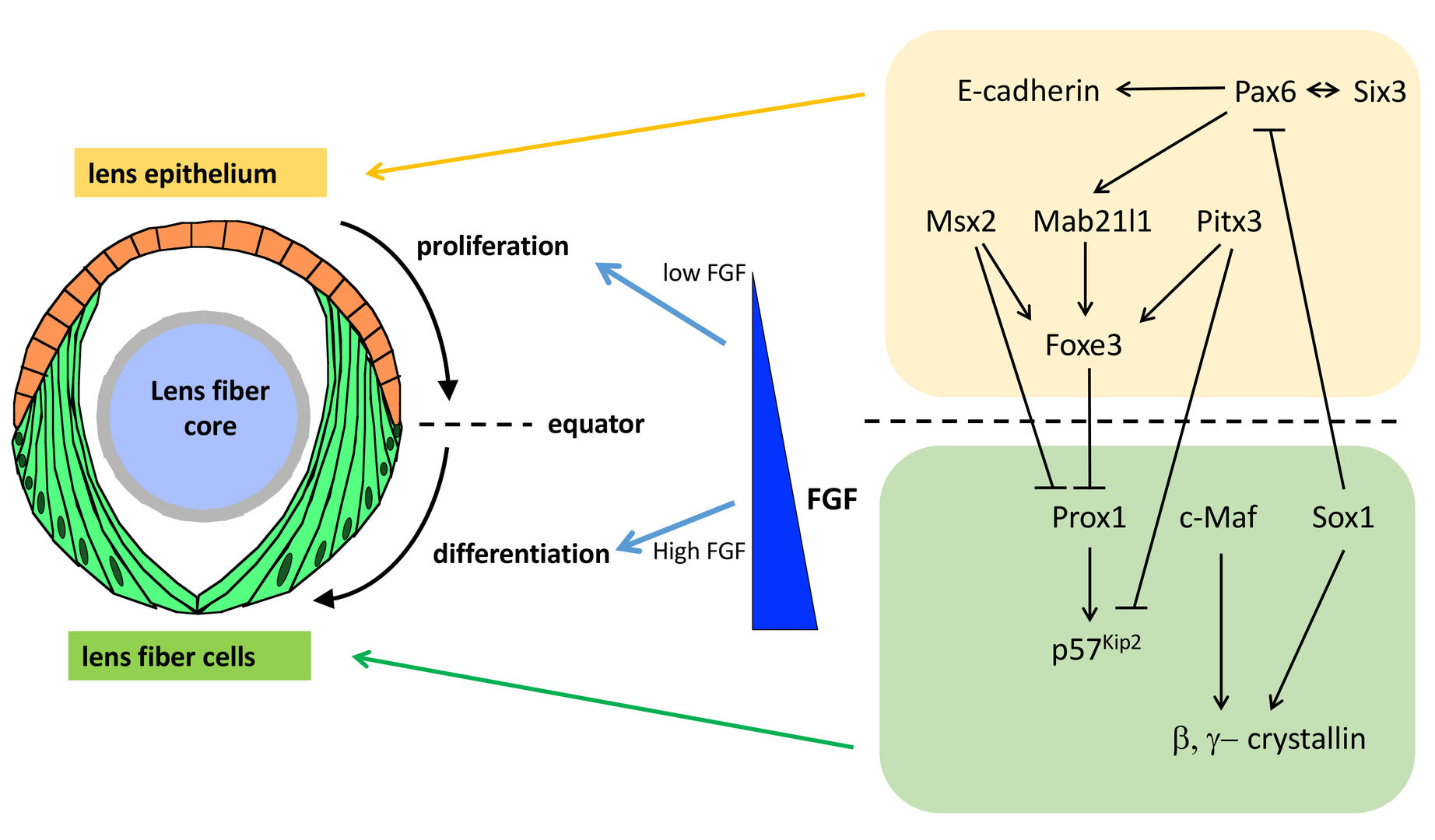
Lens epithelial cells differentiate into lens fiber cells at the lens equator. It was proposed that FGF secreted from the retina forms a low-high gradient along the AP axis of the lens. FGF promotes lens epithelial cell proliferation at low doses, whereas FGF promotes lens fiber differentiation at high doses, supporting the FGF gradient hypothesis. In addition, two groups of transcription factors specify and maintain lens epithelial cell status in the anterior region and lens fiber differentiation status in the posterior region. These two transcription factors mutually suppress each other to keep the equatorial boundary between lens epithelium and lens fiber region.
3.3.1 Mechanisms that regulates equator-specific onset of lens fiber differentiation
In order to elucidate the mechanism underlying equator-specific onset of lens fiber differentiation, we screened zebrafish mutants. We identified zebrafish vps45 mutants, in which the monolayered structure of lens epithelium is disrupted, but forms multiple layers (Fig. 7A). We found that lens epithelial cells undergo ectopic lens fiber differentiation without passing through the equator (Fig. 7A) (Mochizuki et al., 2018). Interestingly, this ectopic lens fiber differentiation does not depend on FGF, suggesting that some novel suppression mechanism of lens fiber differentiation is compromised in the absence of VPS45 activity. It was reported that VPS45 interacts with one of the rab5 effectors, rabenosyn-5, and that VPS45 regulates endocytic trafficking, especially the transport of endocytic cargos from early endosomes to recycling and late endosomes in human cell culture. It is generally accepted that endocytic trafficking dynamically modulates signal transduction pathways. We found that ectopic lens fiber differentiation in vps45mutants is mediated by activation of TGF-β signaling and inhibition by Wnt signaling pathways (Fig. 7B). Thus, VPS45 suppresses lens fiber differentiation in the lens epithelium in an FGF-independent manner. Our findings indicate a novel FGF-independent mechanism that suppresses lens fiber differentiation in anterior lens epithelium and ensures equator-specific commencement of lens fiber differentiation.
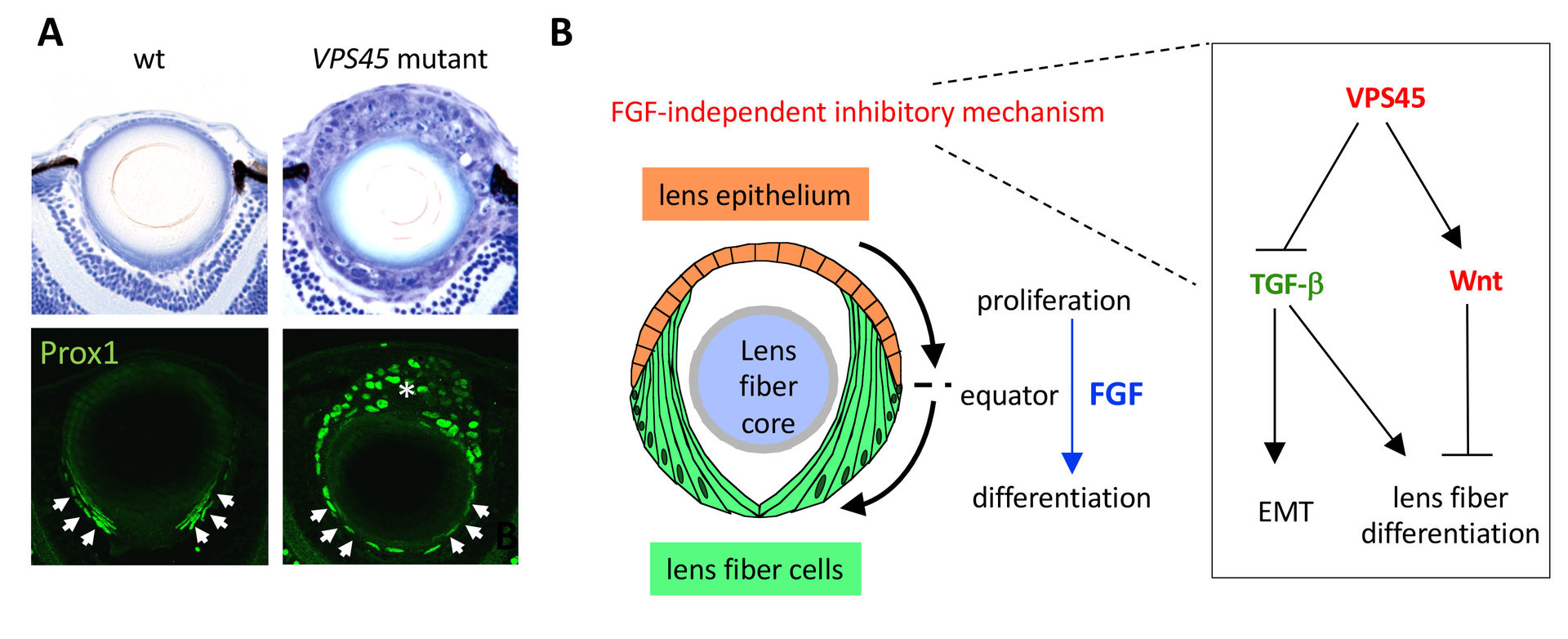
(A) Wild-type and vps45 mutant lenses. Prox1 is a marker of lens fiber cells. Lens fiber differentiation occurs after passing through the equator (arrows); however, ectopic lens fiber differentiation occurs in the lens epithelium of vps45 mutant (asterisk). (B) FGF signaling promotes lens fiber differentiation in the equator. VPS45 suppresses lens fiber differentiation in the anterior lens epithelium by modulating TGF-β and canonical Wnt signaling pathways. This novel suppression mechanism ensures the equator-specific onset of lens fiber differentiation.
4. Publications
4.1 Journals
Asterisks* indicates corresponding authors
- Kinoshita-Kawada, M., Hasegawa, H., Hongu, T., Yanagi, S., Kanaho, Y., Masai, I., Mishima, T., Chen, X., Tsuboi, Y., Rao, Y., *Yuasa-Kawada, J., and *Wu, J. Y. (2019) A crucial role of Arf6 in the response of commissural axon to Slit. Development146, dev172106.
- Mochizuki, T., Kojima, Y., Nishiwaki, Y., Harakuni, T., and *Masai, I. (2018) Endocytic trafficking factor VPS45 is essential for spatial regulation of lens fiber differentiation in zebrafish.Development, 145, pii dev170282.
- *Iribarne, M., and Masai, I. (2018) Do cGMP levels drive the speed of photoreceptor degeneraton? Adv. Exp. Med. Biol. 1074, 327 – 333.
4.2 Books and other one-time publications
Nothing to report
4.3 Oral and Poster Presentations
(Oral, International conference)
- Sugiyama, Y. Live-imaging of collective migration of lens fibre cells, in Resonance Bio – meeting of Bio-imaging for Young Researcher, OIST, Okinawa, Japan, 29th– 30thOct 2018.
- Sugiyama, Y., McAvoy, J., and Masai, I. Fine Tuning of Ocular FGF activity regulates differentiation and collective movement of lens fiber cells, in The XXIII Biennial Meeting of the International Society for Eye Research (ISER), Belfast, Northern Ireland, UK, 9th–13thSept 2018.
(Poster, international conferences)
- Ranawat, N.and Masai, I. Microglial response to ATM-Chk2-p53 mediated neuronal cell death, in The 25thEast Asia Joint Symposium, Chongqing, China, 25th– 27thOct 2018.
- Nishiwaki, Y., Ward, K., and Masai, I. ER-resident BH3-only protein, BNip1, is a safe guard that limits the upper threshold of vesicular transport, in XVIII International Symposium on Retinal Degeneration, Killarney, Ireland, 3rd– 8thSept 2018.
- Hang, C. Y., Masai, I., Shaevitz, J. and Stephens, G. Shoaling behavior of adult zebrafish predominantly depends on retinal vision but not the lateral line, in The 13th International zebrafish conference, Madison, USA, 20th – 24thJune 2018.
- Takeuchi, Y.and Masai, I. Fgfrl1b, a decoy receptor for fibroblast growth factor, is essential for later differentiation of lens fiber cells in zebrafish, in The 13th International zebrafish conference, Madison, USA, 20th– 24thJune 2018.
- Iribarne, M.& Masai, I. Temporal Profile of rod degeneration and regeneration in zebrafish AIPL1 mutant, which is a model for human Achromatopsia, in The 13th International zebrafish conference, Madison, USA, 20th – 24thJune 2018.
- Nishiwaki, Y., Ward, K. & Masai, I. ER-resident BH3-only protein, BNip1, is a safe guard that limits the upper threshold of vesicular transport, in Visual System Development Gordon Research Conference, Lucca, Italy, 20th – 25thMay 2018.
(Invited talks)
- Masai, I.“Mechanism underlying spatial regulation of lens fiber cell differentiation”, Symposium of Sensory Organs Research Initiative,Institute of Protein Research, Osaka university, Osaka, Japan, 15thApr 2018.
(Oral, domestic conferences)
- Sugiyama, Y., McAvoy, J. and Masai, I. Fine tuning of ocular FGF activity regulates differentiation and collective movement of lens fibre cells, in Joint Annual Meeting of 51st JSDB & 70th JSCB, Tokyo, Japan, 5th – 8thJune 2018.
- Nishiwaki, Y., Ward, K. and Masai, I. ER-resident BH3-only protein, BNip1, is a safe guard that limits the upper threshold of vesicular transport, in Joint Annual Meeting of 51st JSDB & 70th JSCB, Tokyo, Japan, 5th – 8thJune 2018.
5. Intellectual Property Rights and Other Specific Achievements
5.1 The Category or Type of Funding, like External Funding, Awards, etc.
Funding
HFSP Research Grant
- PI name: Greg Stephens (Vrije Universiteit Amsterdam)
- Co-PI name: Joshua Shaevitz (Princeton Univ)
- Co-PI name: Ichiro Masai (OIST)
- 2016-2018
KAKENHI (grants from the Ministry of Education, Science and Sport/JSPS)
NA
6. Meetings and Events
6.1 OIST course
- Title: Developmental Neurobiology Course 2018
- Co-organizer:Yoko Yazaki-Sugiyama (OIST), David L. van Vactor (Harvard Medical School, OIST), Hiroshi Kawasaki (Kanazawa University), Hiroshi Kohsaka (University of Tokyo)
- Dates: July 31 – August 12, 2018
- Place: OIST campus
- Keynote speakers: Christiane Nüsslein-Volhard (Max Planck Institute of Developmental Biology), Erwin Neher (Max Planck Institute of Biophysical Chemistry)
- Lecturers: Tom Clandinin (Stanford Univ), Yasunori Hayashi (Kyoto Univ), Takao Hensch (Harvard Univ), Suresh Jesuthasan (Nanyang Technological Univ), Mineko Kengaku (Kyoto Univ), Stephen Liberles (Harvard Medical School), Hitoshi Okamoto (RIKEN CBS), Noriko Osumi (Tohoku Univ), Iris Salecker (Francis Crick Institute), Felix Schweizer (UCLA), Nirao Shah (Stanford Univ), Tomoyuki Takahashi (OIST), Ryohei Yasuda (Max Planck Florida Institute of Neuroscience), Yoshihiro Yoshimura (RIKEN CBS), Stephanie Ann White (UCLA), Yimin Zou (UCSD),
- Tutors: Makoto Araki (OIST), Chong Yee Hang (OIST), Jelena Katic (OIST), Takashi Kudo (OIST), Anna Kuneji (Shinjo) (OIST), Yuichi Morohashi (OIST), Yuko Nishiwaki (OIST), Yuki Sugiyama (OIST), Yuki Takeuchi (OIST)
- Coordinator: Takakazu Yokokura (OIST)
6.2 OIST workshop
NA
6.3 OIST seminar
- Speaker: Dr.Yutaka Kikuchi
- Affiliation: Hiroshima University
- Title: “Control of cell proliferation in zebrafish fin regeneration – position-dependent cell proliferation”
- Date: September 12, 2018
- Speaker: Dr.Luis Carretero
- Affiliation: School of Life Sciences, University of Sussex
- Title: “The α2-chimaerin signaling module and its role in oculomotor development and Duane Retraction Syndrome”
- Date: February 6, 2019
- Speaker: Dr.Wei-Chieh Jerry Chiang
- Affiliation: Department of Pathology, UCSD
- Title: “Endoplasmic Reticulum Stress and Unfolded Protein Response in Retinal Degeneration”
- Date: February 12, 2019
7. Other
Nothing to report.



